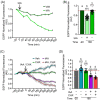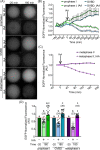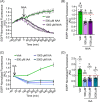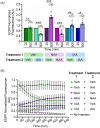Auxin-inducible protein degradation as a novel approach for protein depletion and reverse genetic discoveries in mammalian oocytes†
- PMID: 31299080
- PMCID: PMC6863966
- DOI: 10.1093/biolre/ioz113
Auxin-inducible protein degradation as a novel approach for protein depletion and reverse genetic discoveries in mammalian oocytes†
Abstract
The disruption of protein expression is a major approach used for investigating protein function in mammalian oocytes. This is often achieved with RNAi/morpholino-mediated knockdown or gene knockout, leading to long-term loss of proteins of interest. However, these methods have noteworthy limitations, including (a) slow protein turnover can prohibit use of these approaches; (b) essential roles in early events precludes characterization of functions in subsequent events; (c) extended protein loss can allow time for compensatory mechanisms and other unanticipated events that confound interpretation of results. The work presented here examines the use of auxin-inducible degradation, a powerful new approach that overcomes these limitations through the depletion of one's protein of interest through controllable ubiquitin-mediated degradation. This method has been employed in yeast and mammalian cell lines, and here we demonstrate the utility of auxin-inducible degradation in mouse oocytes at multiple stages of meiosis, through degradation of exogenously expressed EGFP. We also evaluate important parameters for experimental design for use of this system in oocytes. This study thus expands the toolkit of researchers in oocyte biology, establishing the use of this unique and versatile approach for depleting proteins in oocytes, and providing researchers with valuable information to make use of this system.
Keywords: auxin-inducible degradation; meiosis; oocyte; protein depletion.
© The Author(s) 2019. Published by Oxford University Press on behalf of Society for the Study of Reproduction.
Figures








Similar articles
-
The auxin-inducible degradation (AID) system enables versatile conditional protein depletion in C. elegans.Development. 2015 Dec 15;142(24):4374-84. doi: 10.1242/dev.129635. Epub 2015 Nov 9. Development. 2015. PMID: 26552885 Free PMC article.
-
Combining the auxin-inducible degradation system with CRISPR/Cas9-based genome editing for the conditional depletion of endogenous Drosophila melanogaster proteins.FEBS J. 2017 Apr;284(7):1056-1069. doi: 10.1111/febs.14042. Epub 2017 Mar 8. FEBS J. 2017. PMID: 28207183
-
A pre-in vitro maturation medium containing cumulus oocyte complex ligand-receptor signaling molecules maintains meiotic arrest, supports the cumulus oocyte complex and improves oocyte developmental competence.Mol Hum Reprod. 2017 Sep 1;23(9):594-606. doi: 10.1093/molehr/gax032. Mol Hum Reprod. 2017. PMID: 28586460
-
Auxin-inducible degron system: an efficient protein degradation tool to study protein function.Biotechniques. 2023 Apr;74(4):186-198. doi: 10.2144/btn-2022-0108. Epub 2023 May 16. Biotechniques. 2023. PMID: 37191015 Review.
-
Rapid Depletion of Budding Yeast Proteins via the Fusion of an Auxin-Inducible Degron (AID).Curr Protoc Cell Biol. 2014 Sep 2;64:20.9.1-16. doi: 10.1002/0471143030.cb2009s64. Curr Protoc Cell Biol. 2014. PMID: 25181302 Review.
Cited by
-
Phosphoproteomic Approaches for Identifying Phosphatase and Kinase Substrates.Molecules. 2023 Apr 24;28(9):3675. doi: 10.3390/molecules28093675. Molecules. 2023. PMID: 37175085 Free PMC article. Review.
-
Efficient generation of a single-copy eft-3p::TIR1::F2A:: BFP::AID*::NLS allele in the C. elegans ttTi5605 insertion site through recombination-mediated cassette exchange.MicroPubl Biol. 2021 Aug 3;2021:10.17912/micropub.biology.000425. doi: 10.17912/micropub.biology.000425. eCollection 2021. MicroPubl Biol. 2021. PMID: 34355140 Free PMC article.
-
Auxin-mediated Protein Degradation in Caenorhabditis elegans.Bio Protoc. 2020 Apr 20;10(8):e3589. doi: 10.21769/BioProtoc.3589. Bio Protoc. 2020. PMID: 32699809 Free PMC article.
-
Rapid Degradation of Caenorhabditis elegans Proteins at Single-Cell Resolution with a Synthetic Auxin.G3 (Bethesda). 2020 Jan 7;10(1):267-280. doi: 10.1534/g3.119.400781. G3 (Bethesda). 2020. PMID: 31727633 Free PMC article.
-
Targeted Protein Degradation Tools: Overview and Future Perspectives.Biology (Basel). 2020 Nov 26;9(12):421. doi: 10.3390/biology9120421. Biology (Basel). 2020. PMID: 33256092 Free PMC article. Review.
References
Publication types
MeSH terms
Substances
Grants and funding
LinkOut - more resources
Full Text Sources
Other Literature Sources
Research Materials

